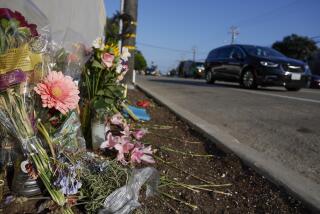Trauma Center Group Backs Insurance Reform : Health care: Coalition urges passage of no-fault bill, sponsored by state Sen. Frank Hill, saying it would help hospitals recoup cost of treating auto accident victims.
SANTA ANA — Saying that most patients admitted to hospital trauma centers are victims of traffic accidents, a coalition of business and health leaders on Tuesday urged passage of no-fault auto insurance to help the emergency centers recoup the costs of care and stay solvent.
Most badly injured traffic victims do not pay their medical bills and therefore represent a significant drain on the state’s 41 trauma centers, according to Trauma 2000, a group dedicated to preserving and expanding the high-tech medical centers.
Although 68.6% of patients admitted to the county’s three special emergency centers in 1989 were injured in traffic accidents, auto insurance payments made up just 2.1% of the revenue that year for the three facilities, according to an analysis by Trauma 2000.
Trauma 2000 founder John West and director Greg Bishop argued that if a no-fault bill sponsored by state Sens. Frank Hill (R-Whittier) and Patrick Johnston (D-Stockton) had been in effect, it would have cut the trauma centers’ tab for uncompensated care by about $5 million in Orange County, and one facility, at Fountain Valley Regional Hospital and Medical Center, would not have been forced to close in December, 1989.
Statewide, no-fault insurance that year would have cut deficits at all trauma centers by $52.8 million to $70.4 million, estimated Greg Bishop, who directed the study and also runs an Irvine consulting firm on trauma centers.
Although the centers would still incur some losses on each traffic case, insurance on every motorist “would go a long way” toward paying hospital bills, he said.
“Since trauma centers essentially serve as auto accident hospitals, their viability depends upon auto insurance covering a fair share of their costs,” Bishop said.
“Affordable auto insurance that pays the medical costs of those injured in traffic crashes is the best way to accomplish this,” he said. “Otherwise, those seriously injured in motor vehicle accidents will receive low-quality care because the trauma center has closed.”
The Trauma 2000 backing was the latest in a string of endorsements for SB 941, the no-fault bill. Republican Gov. Pete Wilson, the Consumers Union and the California Council of Urban Leagues are among the supporters.
The bill would require all drivers to pay $220 for $15,000 minimum coverage for medical care or lost earnings. Under no-fault, a driver’s damages would be paid for by his insurance company, regardless of who caused the traffic accident, and the right to sue would be sharply restricted.
Hill’s chief of staff, Shannon Hood, predicted a hard fight for the bill, which is scheduled for its first hearing in the Senate Judiciary Committee on Tuesday. Its chief opponents this year are the powerful California Trial Lawyers Assn., Ralph Nader and Assembly Speaker Willie Brown, who supports a rival no-fault bill.
Trauma centers are specially equipped hospital rooms where neurosurgeons and medical teams with special training in emergency medicine are on hand 24 hours a day.
Many studies have proved that the high-tech centers save gunshot and traffic victims who otherwise would have died, but many centers have been closed in the last decade. Though the care is still considered valuable, too much of it is uncompensated, hospital officials say.
Reactions Tuesday to the Trauma 2000 study were mixed.
Bishop said Fountain Valley’s center could have remained open if no-fault insurance had been in effect, but that hospital’s assistant administrator, Barbara Patton, is not so sure.
“We had multiple problems. Finances were only one of them,” she said, adding that, for example, the hospital was unable to keep a neurosurgeon on call 24 hours a day, as trauma rules required.
Betty O’Rourke--manager of the county’s Emergency Medical Systems, which regulates trauma centers--said the study’s account of losses is difficult to assess because local emergency centers “have not been willing to share the figures with the county.”
But she said no-fault insurance should help trauma centers--and all 30 of the county’s emergency rooms.
But O’Rourke disputed a comment by West that the local trauma network is ailing. Although Fountain Valley quit the system in 1989, Long Beach Memorial Medical Center joined as a fourth center for Orange County last year.
More to Read
Sign up for Essential California
The most important California stories and recommendations in your inbox every morning.
You may occasionally receive promotional content from the Los Angeles Times.










